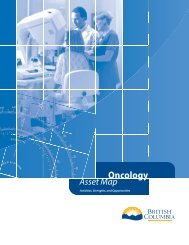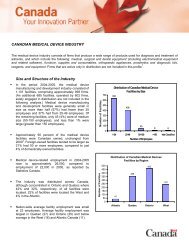Report - LifeSciences BC
Report - LifeSciences BC
Report - LifeSciences BC
- No tags were found...
You also want an ePaper? Increase the reach of your titles
YUMPU automatically turns print PDFs into web optimized ePapers that Google loves.
pharmaceutical coverage programs have been5trending in recent years. At the national level,government-supported expenditures onpharmaceutical products now account for 9.6%of health-related spending (see Figure One).The numbers in British Columbia aresomewhat different. <strong>BC</strong> continues to spendless, per capita, than the Canadian average onprescription drugs (based on data available from2006, <strong>BC</strong>'s expenditure level stood at $466 perperson while the national average was $598). Itis important to note, however, that <strong>BC</strong> isexperiencing the highest growth rate in thenumber of new prescriptions (11.4% against anational average of 8.6%) and the third highestgrowth rate in the dollar value of prescriptions.When looked at over the longer term, <strong>BC</strong> hasseen a substantial increase in the cost of6prescription drugs over the past decade. In1996 the province's PharmaCare programspent $372 million on prescription drugs. Theamount increased to $713 million by 2004 andFigure One: Government health expenditure (GHEX) in Canada,1975 to 2005, by use of funds60,00050,000Hospitals & institutionsMillions Current $CDN40,00030,00020,000Professionals10,000Prescription drugs(patented & non-patented)01975 1978 1981 1984 1987 1990 1993 1996 1999 2002 2005Source: Canadian Institute for Health Information (CIHI), 2005Other5Some caution may be required when considering, in isolation, increased costs in pharmaceutical coverage programs. Itis now well established that increased drug expenditures may simply indicate that drug therapies have been successfullydeployed in a manner that may help to alleviate pressures on other aspects of the healthcare system. The BritishColumbia Medical Association in “A Prescription for Quality; Improving Prescription Drug Policy in British Columbia, (July,2007 – see p.14), said this: “As in any area of public policy, increased spending may be a prudent investment, with gains tobe realized in the future. For example, clinical guidelines and chronic disease management programs have increasinglyemphasized drug therapy as a cornerstone to improving health outcomes and controlling costs. Multiple clinical trialssuggest that use of appropriate heart failure drug therapies may be the most effective way to reduce the cost of carewhile reducing morbidity and mortality: drug therapies can reduce hospitalization by 12% to 35%, depending on thedrug (Goldfarb, Weston et. al. 2004). Nonetheless, within finite budgets, increased spending in one area may also offsetexpenditures elsewhere in the healthcare system. The challenge for healthcare policymakers is to determine if and whenthe investment in prescription drugs – particularly in light of continued growth – is worth the expected return.”6This growth rate is substantially consistent with what has taken place in other provinces and other national jurisdictions.THE REPORT OF PHARMACEUTICAL POLICY RECOMMENDATIONS FOR THE MINISTRY OF HEALTH 4APRIL, 2008















